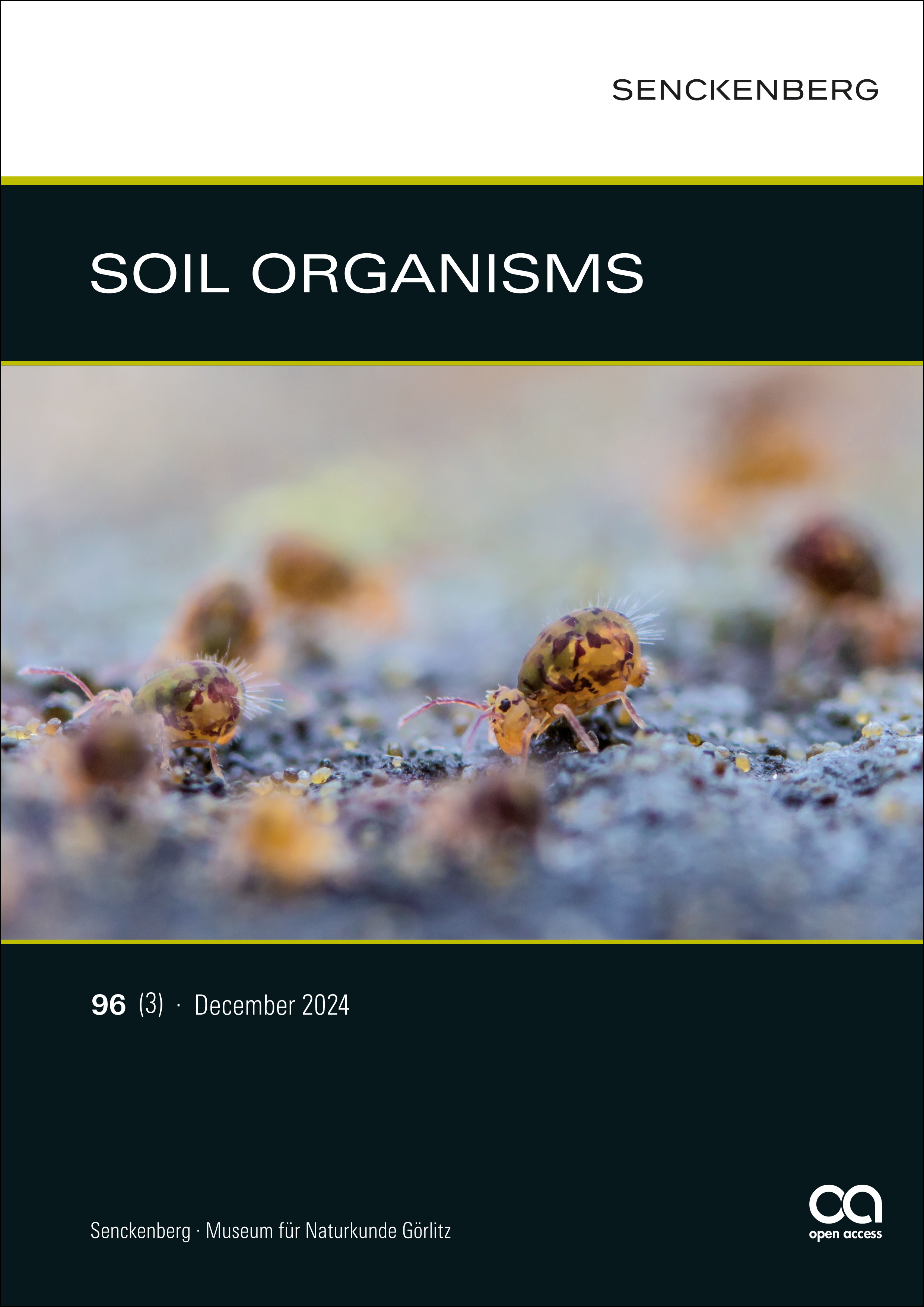Lasius frequens n.sp. – a sister species of the supercolonial pest ant Lasius neglectus showing a differing biology (Hymenoptera: Formicidae)
DOI:
https://doi.org/10.25674/435Keywords:
Invasive ants, Lasius turcicus species complex, cryptic species, numeric morphology-based alpha-taxonomy, stereomicroscopyAbstract
A new sister species of the supercolonial invasive pest ant Lasius neglectus Van Loon et al., 1990 is described based on a broad sample from the Iran. It is named Lasius frequens n. sp. due to its abundance in that region. The strongest difference to the next similar species Lasius turcicus Santschi, 1921, L. neglectus Van Loon et al., 1990 and L. precursor Seifert, 2020 are distinctly longer scapes and terminal segments of maxillary palps. In order to disentangle the complicated situation within this species complex, species hypotheses were generated by exploratory and hypothesis-driven data analyses using numeric recordings of 16 morphological characters within a total of 255 nest samples with 782 worker individuals. The exploratory data analyses NC-part.kmeans and NC-NMDS.kmeans indicated the existence of five clusters. These classification hypotheses were confirmed through a controlling linear discriminant function (LDA) by 99.2 % in NC-part.kmeans and by 97.2 % in NC-NMDS.kmeans. As NC-clustering does not expose hybrid samples, the spatial distribution of the clusters was checked in the simple vectorial space by 2-dimensional plotting of cluster triples in a LDA. There was no indication for substantial interspecific hybridization in any triple plotted. The clusters 1, 2, 3 and 4 could be attributed to the four above-mentioned taxa by clear allocation of the type samples. A fifth, strongly separated, morphological cluster was not described as a separate species but was assumed to represent a setae morph of Lasius turcicus. Lasius frequens n. sp. differs from L. neglectus in having its main distribution in natural habitats but 28 % of the samples were also found in rural and urban habitats. Gynes of L. frequens n. sp. have about 160 % of the mesosoma volume of L. neglectus gynes which indicates strongly developed flight muscles. This morphological trait and the wide distribution over most different habitat types indicate that this species should perform, in contrast to L. neglectus, a normal nuptial flight with long-range flight-dispersal and independent single-queen colony foundation.
Downloads
References
Cremer, S., Ugelvig, L.V., Drijfhout, F.P., Schlick-Steiner, B.C., Steiner, F.M., Seifert, B., Hughes, D.P., Schulz, A., Petersen, K.S., Konrad, H., Stauffer, C., Kiran, K., Espadaler, X., d’Ettorre, P., Aktaç, N., Eilenberg, J., Jones, G.R., Nash, D.R., Pedersen, J.S. & Boomsma, J.J. (2008): The evolution of invasiveness in garden ants. PLoS ONE 3(12): e3838. https://doi.org/10.1371/journal.pone0003838.
Csősz, S. & Fisher, B.L. (2015): Diagnostic survey of Malagasy Nesomyrmex species-groups and revision of hafahafa group species via morphology-based cluster delimitation protocol. ZooKeys 526: 19–59. https://doi.org/10.3897/zookeys.526.6037.
Espadaler, X., Tartally, A., Schultz, R., Seifert, B. & Nagy, C. (2007): Regional trends and preliminary results on the local expansion rate in the invasive garden ant, Lasius neglectus (Hymenoptera, Formicidae). Insectes Sociaux 54: 293–301.
Seifert, B. (2000): Rapid range expansion in Lasius neglectus (Hymenoptera, Formicidae) – an Asian invader swamps Europe. Deutsche Entomologische Zeitschrift 47(2):
–179.
Seifert, B. (2008): Removal of allometric variance improves species separation in multi-character discriminant functions when species are strongly allometric and exposes diagnostic characters. Myrmecological News 11: 91–105.
Seifert, B. (2018): The ants of Central and North Europe. Lutra Verlags- und Vertriebsgesellschaft, Tauer (Germany), 425 pp.
Seifert, B. (2020a): A taxonomic revision of the Palaearctic members of the subgenus Lasius s. str. (Hymenoptera, Formicidae). Soil Organisms 92(1): 15–94.
Seifert, B. (2020b): The Gene and Gene Expression (GAGE) Species Concept: an universal approach for all eukaryotic organisms. Systematic Biology 69(5): 1033–1038. https://doi.org/10.1093/sysbio/syaa032.
Seifert, B. (2021): A taxonomic revision of the Palaearctic members of the Formica rufa group (Hymenoptera: Formicidae) – the famous mound-building red wood ants. Myrmecological News 31: 133–179. https://doi.org/10.25849/myrmecol.news_031:133.
Seifert, B. (2024): Pleistocene population differentiation in the ant Myrmica scabrinodis (Hymenoptera: Formicidae) – a taxonomic borderline case. Soil Organisms 96(1): 11–21. https://doi.org/10.25674/357.
Seifert, B., Ritz, M. & Csősz, S. (2013): Application of exploratory data analyses opens a new perspective in morphology-based alpha-taxonomy of eusocial organisms. Myrmecological News 19: 1–15.
Stukalyuk, S.V., Radchenko, A.G., Akhmedov, A. & Reshetov, A.A. (2020): Uzbekistan — the alleged native range of the invasive ant Lasius neglectus (Hymenoptera, Formicidae): geographical, ecological and biological evidences. Zoodiversity 54(2): 111–122. https://doi.org/10.15407/zoo2020.02.111.
Ugelvig, L.V., Drijfhout, F.P., Kronauer, D.J.C., Boomsma, J.J., Pedersen, J.S. & al. (2008): The introduction history of invasive garden ants in Europe: integrating genetic, chemical and behavioural approaches. BMC Biology 6: 11. https://doi.org/10.1186/1741-7007-6-11.
Downloads
Additional Files
Published
Issue
Section
License
Copyright (c) 2024 Bernhard Seifert

This work is licensed under a Creative Commons Attribution 4.0 International License.
Soil Organisms is committed to fair open access publishing. All articles are available online without publication fees. Articles published from Vol. 96 No. 3 (2024) onwards are licensed under the Creative Commons Attribution 4.0 International (CC BY 4.0) license. Articles published from Vol. 80 No. 1 through Vol. 96 No. 2 are available under the previous terms, allowing non-commercial, private, and scientific use.





